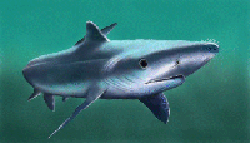Blue Shark

Common Name: Blue Shark
Scientific Name: Prionace glauca
Description
Blue sharks are a distinctive dark indigo blue on top, which blends to a lighter bright blue down their sides and ends with a bright white under belly. Soon after death their blue coloration fades to dark gray. Blue sharks have long slender bodies and pointed snouts. Their pectoral fins are long and sickle shaped. The teeth in their upper jaw are triangular, serrated and curved? their lower teeth are narrower and very sharp. Blue sharks generally attain a length of 6 to 8 feet and weigh from 50 to 200 pounds. Large blues can grow to 12 feet in length and weigh over 400 pounds.
Diet
The Blue Shark eats mainly fish and cephalopods such as squid. Baby Blue Sharks are nourished via a yolk sac placenta, and are born at a length of 35-50cm. Adults grow to 3.83m
Blue sharks reportedly feed on anchovy, mackerel, hake, dogfish, squid and pelagic crustaceans including euphausiids. Elsewhere also known to feed also on small sharks and seabirds. May feed more actively at night, with highest activity in the early evening.
Behaviour
Blue sharks are pelagic and migratory in nature. They frequently swim together at the surface and are known to follow boats to get a free meal. Blue sharks are a popular sportfish in the Gulf of Maine because they are plentiful and are easy to catch. Most blue sharks are released when caught because of the poor quality of their meat as food. Chumming with herring, mackerel and menhaden works well when trying to attract these sharks.
This species is pectoral fins very long, narrow, pointed, Caudal fin nonlunate, Body slender, Snout rounded, long, Color dark blue above, bright blue with metallic hues on sides, white underside, First dorsal fin closer to pelvic fins than to pectoral fins.
Habitat
Offshore; relatively cool waters 45-70°F (7-21°C); surface to about 1,970 ft (600 m).
Life History
Maximum reported size is 396 cm TL (~13 ft) but blue sharks taken off the U.S. West Coast average much smaller are seldom over 260 cm TL or 8 ? ft. For Pacific blue shark, size and age at 50% maturity in males is 203 cm TL or 6 ? ft. and 4-5 years old, and in females at 186 cm TL or 6 ft and 5-6 years old. Maximum age is estimated to be at least 20 years.
Special Features or Habits
It is the most wide-ranging shark species, being recorded in all tropical and temperate seas, from 50oN to 40oS. The Blue Shark is usually found in water of 12oC to 20oC, and is recorded from the surface to a depth of 350m. In Australia it is recorded from all marine waters except the Arafura Sea, Gulf of Carpentaria and Torres Strait.
Location or Region Found
Newfoundland, Canada, to Argentina, including Gulf of Mexico and Caribbean Sea. Common in U.S. Northeast and mid-Atlantic.
 Deep Sea Crabs
Deep Sea Crabs